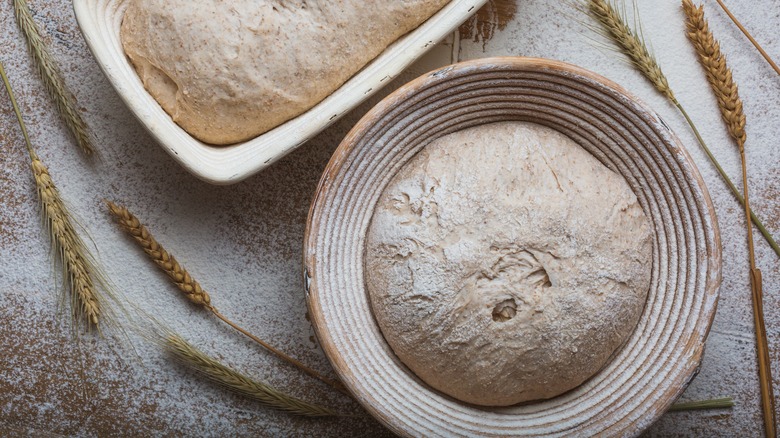Here's The Best Way To Clean Your Banneton Basket
Bread baking is both an art and a science. And while the process is based on precise chemical reactions and the flexibility of experience, home bakers can benefit from specialized tools to make the meticulous steps a little easier. Some of these tools may spark debate over their actual utility, but the banneton basket is a staple for professional and amateur bread bakers alike.
A banneton, also called a "brotform," is a container that holds your dough as it proofs. Usually, these proofing baskets are made from rattan or wood pulp that's coiled in a circular, oval, or oblong pattern and sometimes include a cloth liner — which means that the process for cleaning them is a little more complicated than just throwing them in the dishwasher.
To wash your banneton, run it under cold water or let it soak for a couple of minutes. You can use a sprayer nozzle to get any hardened, crusty flour out from the cracks of the coil; if you don't have a sprayer or encounter particularly obstinate flour flakes, you can scrub gently with a stiff brush or damp cloth. The liner can be soaked in warm water and, if necessary, a small amount of dish soap. The baskets need to be dried very thoroughly every time to avoid mold buildup — a warm spot in the sun can work, but you can also set them on top of the stove while your bread bakes or even let them sit very briefly in a warm oven.
Keep your banneton basket in top shape
This thorough cleaning process is important for maintaining your banneton when a thick flour crust starts to build up, but you don't need to wash it every time you use it. A thin layer of flour is crucial for ensuring the dough doesn't stick to the container and can be easily removed after the bread proofs — adding that layer is called "seasoning" or "conditioning" and needs to be done before you start baking. To season, you'll mist the basket with water, dust the banneton with flour and work it into the grooves, then gently tap out the rest. This should be done when you first get your basket and after every wash.
Normally, though, you should tap out excess flour in between bakes to prevent some of this buildup. You should also allow the basket to air out for a few hours after it's used so that mold doesn't start to grow, and when you're ready to put it away, store it somewhere dry and well-ventilated. If the basket does end up with some mold growing in it, you can put it in the oven for about 45 minutes at 250 degrees Fahrenheit to kill the mold — then just brush it out.
How the basket will elevate your bread baking experience
A banneton requires a little extra care and maintenance, but it's a tool that many bakers will swear by to get a perfect loaf every time and to more easily proof your bread. The container helps your dough maintain its shape and rise up while it is proofing — without it, the dough could flatten out too far and rise outwards. When the dough rises in a banneton, your bread will keep its structure, resulting in a more even bake. The material of the banneton will also help with air circulation, allowing the dough to breathe during proofing, and absorbs some of the excess moisture.
With a banneton, you'll be whipping up delicious, uniform loaves like the professionals in no time. All it takes is some flour and a little attentiveness. The basket may need more attention to maintain than many kitchen tools, but in return, it will give you an easier experience when making bread and an elevated outcome.


